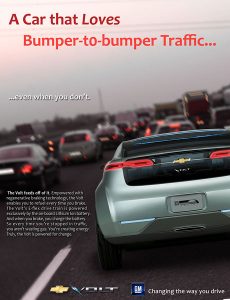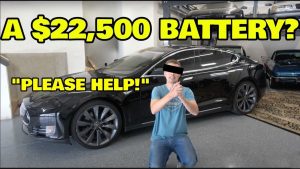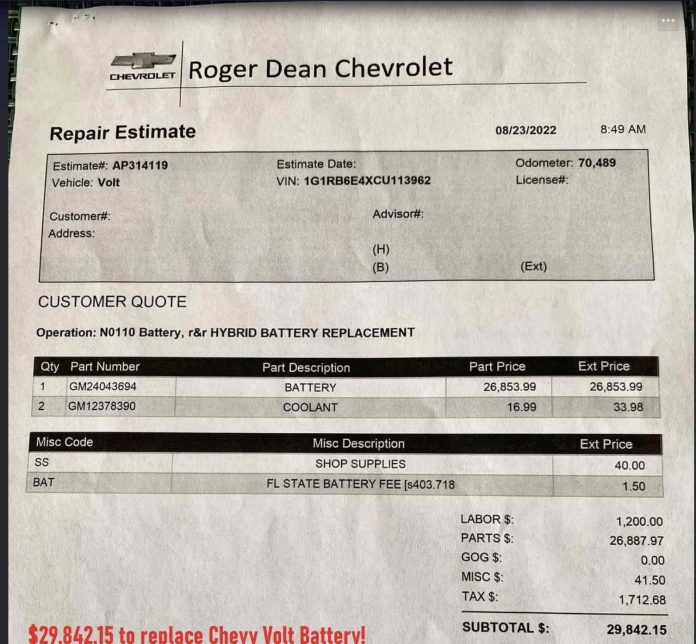Well, the goods news is that owners of the Chevy Volt – which is (well, was) the only electric car that didn’t tether its owner to an electrical outlet and so didn’t come standard with the functional gimps that afflict every other electric car – may not have to spend as much as the car itself cost when it was new on a new/replacement battery for the car.
You may have seen the sphincter-tightening repair estimate circulating on the ‘Net emanating from Roger Dean Chevrolet in Cape Coral, Florida. It’s a real dealership – and so is the estimate. Which estimates the cost of replacing the battery in a customer’s 2012 Volt to be in the vicinity of $30,000 – most of that being the $26,853.99 cost of the replacement battery (labor being an almost incidental $1,200).
Fact-checking site Snopes acknowledges the reality of the estimate – and the cost – but tries to soften the blow by pointing out that the battery for the first-generation Volt has been discontinued – italics for a reason – and the replacement is produced by a third party and this accounts for the (what’s the proper word?) ludicrous replacement cost.
Snopes quotes a representative of the dealership, who said thusly:
“This is an estimate for a 12 year old (ten, actually) vehicle out of warranty and for a battery that is extremely hard-to-get, due to the technology of the 12-year-old vehicle.”
Italics added.
Marvel at this hyper-accelerated techno-economic obsolesceing.
The car in question is a mere ten years old, which means it is two years newer than the average age of non-electric cars currently in use as daily drivers – which is 12 years old. That will still be in use for years to come, most of them.
These cars have years of driving life left because in the first place, the components that make them go (Star Trek Pakled reference) will usually keep going for at least 15-20 years or even longer before something major needs to be replaced, such as the transmission or the engine. And in the second because those major components can be replaced at a cost that isn’t disproportionate to the worth of the vehicle, itself.
It is sensible to spend say $3,000 to replace a failed transmission in an otherwise serviceable twelve-year-old vehicle that will probably continue to be drivable for another twelve years.
It is – what was that word, again? – ludicrous to spend almost $30k to replace the battery in an EeeeeVeeee that is only twelve years old but not worth anything without a functional battery that will cost almost as much as the car itself cost, when it was new, only twelve years ago.
And that will almost certainly need to be replaced again – years before another ten years go by.
This is why the first-generation Volt described in the estimate is rendered economically as well as functionally useless after just twelve years and not even 80,000 miles. It is also a cautionary tale for anyone considering buying any EeeeeVeee, for the same problem applies to all of them.
The “technology” – meaning the battery – is almost always specific to a particular generation (i.e., year/make/model) of EeeeeeVeeee. It fits that model – and only that model. When that model of EeeeVeee is no longer made – when it is succeeded by an “all new” and “updated” model – its battery pack is no longer made, either. There is the supply that exists when production ends – and that’s it. After the supply dries up, the cost goes up – due to the fact that even if a third party makes a replacement (as in the case of the Volt) it only makes a few because there are only so many of that specific year/make/model of EeeeVee that will ever need that particular battery.
So the cost of each one goes up – for the same reason that the cost of any low-volume item is higher than the cost of a high-volume item, which can be sold for less because lots of them can be sold and the investment cost made back on volume rather than high unit cost.
This be that “dismal science” called economics – which many EeeeeeVeee owners do not comprehend . . . until they are presented with the bill. It is not just “first generation” Volt owners who will be presented with it, either. Ask the owner of a “first generation” Chevy Bolt how much it costs to replace its battery. If they can find a battery. Or the owner of a “first-generation” Nissan Leaf. Same goes for Teslas.
Same goes for all EeeeeeVeees.
Now, as Snopes points out, it is possible, in some cases, to suss out third party replacement battery packs for these no-longer-supported (by their original manufacturer) EeeeeVeees. And some cost less than the price quoted by Roger Dean Chevrolet. A search around the ‘Net uncovers replacement first-generation Volt battery packs that only cost about $6,000 (not counting install labor).
Of course, this happens to be just about the worth of a 12-year-old Volt, after spending $6,000 on a third-party replacement battery pack that probably won’t last as long as the Volt’s original battery pack.
And never mind the “environmental impact” of all these prematurely obsoleted EeeeeeVeees – which will have to be replaced (along with their battery packs) years before almost any non-electric car becomes functionally (and economically) no longer worth fixing with another EeeeeVee – and another battery pack.
It’s almost as “effective” as the “vaccines.”
. . .
Got a question about cars, Libertarian politics – or anything else? Click on the “ask Eric” link and send ’em in! Or email me at EPeters952@yahoo.com if the @!** “ask Eric” button doesn’t work!
If you like what you’ve found here please consider supporting EPautos.
We depend on you to keep the wheels turning!
Our donate button is here.
If you prefer not to use PayPal, our mailing address is:
EPautos
721 Hummingbird Lane SE
Copper Hill, VA 24079
PS: Get an EPautos magnet or sticker or coaster in return for a $20 or more one-time donation or a $10 or more monthly recurring donation. (Please be sure to tell us you want a magnet or sticker or coaster – and also, provide an address, so we know where to mail the thing!)
My eBook about car buying (new and used) is also available for your favorite price – free! Click here. If that fails, email me at EPeters952@yahoo.com and I will send you a copy directly!












Back of the napkin math….
Chevy Volt got 70,789 miles….
Compact Cars, as a class get an average of combined 23mpg, city 21mpg and highway 27mpg.
So 70,789 miles at 21mpg, is about 3370.905 gallons.
The Chevy Volt hybrid gas equivalent mpg, and best case 60mpg [gas/electric power]; use 1,179.816 gallons of fuel
Using the avg yearly gas prices, and just selecting the worst case scenario of gas prices I selected the two highest recorded prices and averaged them [July 2008 $4.114, June 2022] of $5.005 a gallon], $4.5595/gal.
Comes that the Comoact Class would average out to $15,369.64 in gas costs at $4.5595/gal
The Chevy Volts better mpg for a total of $5.379.374 spent on refueling. Saving almost $10k over the 11 or 12 years.
That $10k in gas savings is entirely used up at the initial purchase price $41,000 MSRP. The 2010 average compact class size car MSRP was about $28,000.
Even if you add in the costs of needing a new transmission at every 70,000 miles, you’re still ahead, adding in $2,000
You never recoup and never will save any money buying an EV, or even an EV-Gas hybrid
Don’t an EV, way too many problems, they are unsafe and a nightmare.
Norwegian Tesla Owners Go On Hunger Strike Over Company’s Poor Customer Service And Build Quality
The owners are taking exception with “poor customer service” and being “ignored by the automaker” as phone calls go unanswered.
According to the report, the list of issues with their vehicles includes
“poor paint quality,rust,
inability to meet claimed battery life, short battery life, these lithium batteries have a short life and cost $22,000 to replace
failing heat pumps, so no heat in the car you freeze to death…and heat pumps don’t work in very cold weather = you freeze
stuck door handles in the cold, can’t get in the car, you freeze to death
yellowing infotainment screens (that Tesla told the NHTSA were only meant to last “5-6 years” anyway).” So a tesla life span is 5 – 6 years….lol
issues with the car’s lights,
bubbling seats,
water collecting in the trunk, not even sealed properly, low quality
loose trim pieces,
reduced power…not good battery or motors issue
“autopilot does not work properly,,,very dangerous, lots of crashes, drives into walls…lol
Regardless, owners felt like they had to escalate the issue because the company’s customer service is awful. They complain about spending “an inordinate amount of time waiting on hold to actually speak with someone from Tesla” and not having their calls returned.
https://www.zerohedge.com/markets/norwegian-tesla-owners-go-hunger-strike-over-companys-poor-customer-service-and-build
Watch a Tesla owner blow up his Model S with 66 pounds of dynamite instead of paying $22,000 to repair it, replace the battery…lol
https://www.businessinsider.com/tesla-owner-blows-up-car-instead-paying-repair-battery-video-2021-12?op=1
Are you ready for the EV revolution?
Coming to a gas station near you.
https://twitter.com/CitizenFreePres/status/1564788253357707264
Got another one for you Eric. Today an Ireland a small business Poppy Fields Café and restaurant in Athlone, said she was stunned by the size of the bill
and posted their electric bill on twitter:
https://twitter.com/DolanGeraldine/status/1564392353300889603
https://ibb.co/BTY6BFW
source:
https://www.msn.com/en-ie/money/news/caf-c3-a9-owner-in-shock-after-e2-82-ac10000-electricity-bill-for-just-two-months/ar-AA11hjSv?fromMaestro=true
9836.92 British Pounds = $11463.85 US Dollars
Note: The Pound is considered to be one of the most stable currencies in 2022, but not long ago it was equivalent to a pound of sterling silver, today’s value of 1 pound of silver, enter 1 in the box:
http://coinapps.com/silver/pound/calculator/
—————-
in a related story
https://www.bloomberg.com/news/newsletters/2022-08-25/more-americans-than-ever-can-t-afford-to-pay-their-electric-bill
“A “Tsunami of Shut-Offs” Is Coming
US electricity prices surging and more people than ever are struggling to pay the power company. More than 20 million American households have fallen behind on their utility bills, about 1 of every 6 homes, and the amount they owe has doubled since before the pandemic.
With more people owing more money, utilities are getting more aggressive about cutting off delinquent customers.”
—————–
in more related WEF news:
Klaus Schwab says “You’ll own nothing in 10 years”
—————–
In more related CNBC news:
California bans the sale of new gas-powered cars by 2035
Published Thu, Aug 25 2022
This means the demand for electricity will go up exponentially.
—————–
In more related Federal Reserve news:
https://fred.stlouisfed.org/series/WALCL
PhD Economist at the Fed: “The idea that the money supply is related to the price level is ludicrous, we at the Fed, who have many PhDs and are very smart, have found no correlation to the printing of money and the misery of the people when they can no longer pay their bills.
yeah but the female has a ukie flag next to her login
Time will tell, but the avg lifespan of an EV battery may be about 100,000 miles.
If this holds true, owners can expect to spend $20,000+ every 100,000 miles or 8 years.
As has been stated, there are not enough raw materials known on earth to replace all the ICE cars in the USA with EV. Short battery life compounds that problem. Will we have millions on EVs on the road that can no longer find a battery at any price?
People bought EV’s because they wouldn’t have to buy gas, so driving around would be almost free, that is what the advertising implies. Ev’s are supposed to be way cheaper to run/own.
If you look closer it is a lie…..
Comparing cost per mile, 10 years, 100,000 miles:
Tesla EV and VW diesel
I saw rates somewhere at $0.14 per kwh at home, that is due to probably triple very soon.
in Europe it costs $0.72 per kwh, coming here soon.
I saw rates nation wide at fast chargers outside home at $0.40 per kwh
What test drivers are actually getting driving in the real world driving EV’s is they are getting 2.4 miles of range for every kwh
An EV just sitting loses:
tesla says a daily 3%-5% stationary range consumption.” (just parked) leakage, batteries leak power, ice cars don’t
90 kwh x .05 = 4.5 kwh lost per day leakage x $0.14 = $0.63 per day just parked = $0.02 per mile
Ice diesel:
The 2014 Volkswagen Golf BlueMotion diesel, capable of 73.5 mpg U.S. it has a 971 mile range, the perfect car.
VW diesel 100 mile fuel consumption = 1.36 gallons @ $4.00 gallon = $5.44 = $0.0544 per
mile
Tesla EV @ home 100 mile fuel consumption = 41.66 kwh @ $0.14 kwh = $5.83 = $0.0583 per mile
Tesla EV @ fast charger 100 mile fuel consumption = 41.66 kwh @ $0.40 kwh = $16.64 = $0.16 per mile
the tesla $22,000 battery is used up, worn out in 100,000 miles. = $0.22 per mile for the battery use,
the battery use cost is higher then the electricity used. A hidden cost, nobody told you about. maybe a lawsuit?
Tire costs
The tires on EVs tend to wear out faster due to the additional weight and extra torque that hits the road. Plus, EV tires typically have less tread to improve range and decrease noise, they need special more expensive HL rated tires.
Tesla tire size 235 35 20 $391.00
VW Golf tire size 225 45 R17 $119.00
In 100,000 miles if the tesla needs 4 replacement sets = $391.00 x 16 tires = $6256.00 = $0.06 per mile
In 100,000 miles if the VW Golf needs 2 replacement sets = $119.00 x 8 tires = $952.00 = $0.01 per mile
Tesla EV costs $50,000 depreciation over 10 years is $39,500 = $0.39 per mile
the VW diesel costs $24,355 depreciation over 10 years is $19,240 = $0.19 per mile
Tesla EV costs for maintenance and repair: $1000.00 per year = $0.10 per mile
VW diesel costs for maintenance and repair: : $1000.00 per year = $0.10 per mile
Tesla @ home charger total cost per mile = $0.84
Tesla @ fast charger total cost per mile = $0.94
VW diesel total cost per mile = $0.35
Re: Tesla EV and VW diesel comparison…
The VW diesel cost per mile includes the gas road tax, the Tesla EV doesn’t include that, but it will pretty soon….watch…
This doesn’t include insurance costs, if insurance costs $3.00 per day = $0.11 per mile
This thought just occurred to me: how many EVs that were purchased recently will, when the battery goes bad a certain number of years from now, will succumb to “jewish lightning” (not to offend anyone; it’s just a term that means to purposely destroy something for the insurance money after the owner no longer wants it but needs the money for it)?
Sure lots…
In the 2008 financial crisis in Iceland they say you could hear explosions in the middle of the night, people were going broke, everything crashing (we are back there now, stock market, crypto and real estate are crashing right now), so to escape high payments on their Landrover SUV’s they would light them on fire, you could hear them blow up….lol
listen for explosions….lol
check this out….
Watch a Tesla owner blow up his Model S with 66 pounds of dynamite instead of paying $22,000 to repair it, replace the battery…lol
https://www.businessinsider.com/tesla-owner-blows-up-car-instead-paying-repair-battery-video-2021-12?op=1
that video has been seen 5 million + times….lol….someone said that would pay $41,000 from Utube, so he could afford to blow it up….
Indeed! Now I’m wondering if comprehensive insurance policies will even cover BEVs (otherwise the insurance company would be losing a lot of $) in the future. As an alternative, they may value, for example, an 8-year-old Model 3 at like $500, whereas a regular car (like an 8-year-old Camry) would be valued at something like $10,000
Thanks for digging into this story Eric. This would be a truly devastating blow for any well-meaning driver that just wanted to save money on transportation. Leaving aside virtue signaling the owner likely bought the Volt thinking they could recoup the higher cost on fuel and maintenance savings over years of trouble free commuting. EV’s have fewer moving parts and therefore require less maintenance, or so we’re told. It’s especially damning that the cars failure wasn’t in the gas engine or transmission, it’s the wondrous green battery tech that’ll help us kick our “fossil” fuel habit. Shame on GarbageMotors for their deceit and complete arrogance toward their customers. Discontinuing battery packs for the bolt and volt shows GM is only interested in “green” when it’s stamped with dead presidents. May their sales lots and factories self immolate.
Here’s a story from earlier this summer about a family dealing with battery replacement for a EV Focus which cost more than they paid for the car itself used.
I find it interesting that these stories come from Florida and not Southern California. Having lived there for over 40 years, I know about the FL environment being harsh on any electronics not protected by air conditioning, and I gotta wonder about the longevity claims of the manufacturers who develop and test in very specific West Coast microclimates, particularly Tesla.
https://www.foxbusiness.com/technology/florida-family-electric-car-problem-replacement-battery-costs-more-vehicle
BTW, don’t feel too sorry for the family. A little background check revealed an address in what I iknow to be a very wealthy area of St. Petersburg, FL.
I bought a used IBM Thinkpad laptop years ago- Great ‘puter and still to this day works great- but the battery is not too robust, and since I would like to use it without plugging in, I thought I’d buy a new battery for it. Unfortunately, IBM no longer makes that battery- nor does any major brand-name manfacturer…all that’s available are no-name Chinesium third-party batteries….and they ALWAYS end up sucking…so no battery for my perfectly functional laptop.
Same with my former digital camera….still works great, but Sanyo stopped making the battery years ago, and the turd-party ones which are available are good for nothing- Had to buy a new camera. (Got a Nion now which takes AA rechargeables).
Bad enough with these li’l devices and appliances…but with something on the scale of a CAR?! How can people who fail to anticipate this manage to drive? -And such will be the case for all the plug-ins, too. “Oh, sorry sir, but your 10 year-old $87K Tesla uses a battery which is no longer made- it’s obsolete technology, ya’ know…Do you really want to be seen in that old dinosaur anyway? Look! The software in your car is no longer even supported! Throw it away and buy a new one. The new Tesla LGBTQ+-? gets 0.0002 therms of a BTU per every Kwh of post-generator pre-transmission electrons….you’ll be really saving the planet now”.
The common problem to “Orphaned” Tech. The average user simply doesn’t have the means to improvise. And yes, just like the Tesla with software no longer “supported” (i.e., it works as well as it did when new, but whatever current Operating System that Teslas network into won’t accept it anymore…the most straightforward method of “planned obsolescence” ever devised! It’s been that way with “Sail Fawns”, as Eric puts it, partly b/c the available memory has increased, and rather cheaply too, but along with it comes sloppy coding and especially “BLOATWARE”. That is, when you download something from the Apple or Google store for your phone, you’re getting literally more than you bargained for with that app, including SPYWARE. You can have a ten year old cell phone which is perfectly functional, but it’s apps are no longer accepted, and some cell service providers won’t even allow them…the same devices that, when new, some kid in one of their stores was pushing so he’d get his bonus!
Hi Douglas,
Ah yes. And we were talked into giving up $25 corded wall phones that worked reliably for 50-plus years…
Ah, remember those INDESTRUCTIBLE phones from Western Electric, AT&T phone manufacturing outfit? They weren’t much on “innovation”, as it took until the 70s for “touch-tone” to replace the rotary dial (by then, phone switching networks could easily keep up, which before had been the reason to use a rotary dial). Once the keypad was the default mode, it let AT&T get “stylish”, well, sorta, with things like the “Trimline” and the “Ericafon” (which was popular in the FRG). It seemed every home in suburbia had the wall-mounted phone in the kitchen with a twelve-foot coiled cord, so Momma could yak as she cooked!
Many states have no compensatory road tax (gas tax)…..Yet.
Add that into your cost per mile calculations.
Oh, the tech is already there. I visit a relative who’s been seriously ill for over two months, he’s in a very well-known hospital in the Bay Area. The bridges across the Bay, like the Dumbarton Bridge (the one I’d take if the Alviso Freeway is hopeless clogged up) have dispensed with toll booths and human collectors; it’s leap-frogged from chip devices on a “stickie” you place near your rear-view mirror to tech that reads your license plate. You just drive through the booth at 25 mph so your plate is read. If you have a “Fastrak” subscription, it automatically charges the credit card on file, if not, you get an invoice to be paid promptly. IDK if you go the invoice route if a “service” fee is attached. This approach is also used for the HOV lanes, which used to be just “qualifying” vehicles, which are posted. It varies as some routes require THREE per car, most just TWO. It used to be Priuses (Prii?) and other hybrids, but CalTrans did away with that as they got to be more common, same with EVs. But if you’re willing to pay the toll, you can use the HOV lane if you’d otherwise not qualify, it’ll just cost, more so in “peak” times. The plate-reading tech is used to bill folks that have to pay.
It should be obvious that this would make easy an approach to simply convert freeways into TOLL roads, and still hit us with high fuel taxes. This is already done in Texas, where many of the news freeways in the “Metroplex” were built with revenue bonds, there are still truly “FREE-ways” if you’re willing to endure the ever-present traffic jams. So, a trip from where my younger son lives near Fort Worth to, for example, see my sister and her family that live on the other side of the Metroplex might cost about $15 round trip in tolls if he takes the “121”, the Sam Rayburn Tollway or “SRT”, versus going up I-35 to Denton and going across town on the US-380 expressway. If it ends up being workable enough for the greedy bastards, this form of literal “highway robbery” might just be extended to “surface” streets!
BTW, a little anecdote about HOV lane enforcement…back when my youngest, my “little goil, dere” (Archie Bunkerism) was a newborn, I took her to the doc for a checkup and was on the 80 freeway with her tucked in her car seat in the back. The car I was driving was an ’91 Chrysler New Yorker Fifth Avenue (I miss that thing, it was like driving your sofa around), so she wasn’t readily visible. I used the HOV lane, because, well, TWO persons, and I got pulled over as obviously the cop saw only me and thought he had a easy citation. When he spoke, he says, “Sir, you realize you’re travelling by yourself in the ‘diamond’ lane?”. I jerked my thumb towards the back seat towards my baby girl, fast asleep. The poisoned look on his face was PRICELESS. If only smartphones existed in early 2001, I’d have loved to get that on video! The exasperated “porker” then said, “I don’t think a BABY should qualify!”. I asked the officer if he’d ever read Dr. Seuss’ “Horton hears a Who”, and quoted, “A person is a person, no matter how SMALL”, and if he was going to cite me anyway, I’d happily bring her with me to court as EVIDENCE. Try that shit nowadays and you’ll get your ass kicked.
Hey Eric, ) you can still drive the car. Not what you signed up for but at least you still have a usable vehicle.
) you can still drive the car. Not what you signed up for but at least you still have a usable vehicle.
Preaching to the choir here about the all around uselessness of EV’s, but I have a question specific to the Chevy Volt: isn’t the design similar to a diesel electric locomotive in that the gas engine powers a generator that can run the electric drivetrain all by itself? IOW if the battery is dead (or missing
Hi Mike,
The Volt was unique. Unlike hybrids – which have IC engines that primarily propel the car (with “assistance”) from the electric motor (plug-ins are capable of all-electric propulsion for short distances) – the Volt’s IC engine was primarily tasked with keeping the battery charged, so as to keep the electric propulsion going. It was actually a neat solution to the EV problem. But the problem is it cannot propel itself at all if the battery is croaked.
This, IMO, was the BETTER approach to a hybrid design, as de-coupling an IC engine from a gearbox, no longer required (electric motors generate peak torque at zero rpms, which is why EVs can “scoot off the line”), and optimizing it to drive a motor/generator (doubles as it’s “starter”) meant it could be optimized to run at a steady rpm with simple controls…which would almost certain mean a DIESEL. Then you’re talking both an engine optimized for fuel economy AND emissions. However, it’s going to have different characteristics of acceleration and “feel” than most vehicles in its class; and an automaker isn’t going to invest BILLIONS in R&D, facilities, and tooling if the car is completely different. Look at how the Edsel bombed, sales-wise, not only a victim of bad timing (1958-59 recession) and a questionable niche placement (better than a Ford, but not quite a Mercury), never mind that “horseshoe collar” front grille that looked like a gaping vagina.
Hi Douglas,
I agree – the Volt was a clever design. I laud it, so long as it’s simply offered and people are free to buy it – as opposed to being the partial birth abortion result of government “mandates.” That is the essence of my objection to EeeeeVeees as a class!
One piece of advice I give friends/associated that ask me when they are trying to make a large investment is to check parts cost/availability of a 5 year or 10 year old similar model.
Some examples are:
1. Brother in law wanted to buy a farm tractor and knew I had just researched them and bought one. Mine was $12K and is now 20 years old, has never broken, and I can still get all the parts for it. He cheaped out, spent half what I spent, and his ‘asian copy of a tractor’, lasted less than one year, broke a very important hydraulic diversion valve assembly that he couldn’t get, even one year later. A very large paper weight.
2. dirtbikes, etc… I get asked constantly if this ‘XXX brand’ dirtbike for themselves or their kids is good. I give same advice above about parts. approx. half dismiss my advice and then bring them to me 6 months later to try and fix them. I almost never can. another large paperweight.
The same thing can be researched with these EV cars, although there aren’t as many ‘old’ ones yet. But they will be.
Just replaced the battery in a 2012 Nissan Rogue yesterday. It set me back a whopping $206 with tax, plus a $20 core charge I’ll get back this afternoon…and that was for a maintenance-free AGM battery, which I prefer because it’s sealed up and won’t spew acid all over the battery terminals (been there, done that, made replacement a royal pain). They only last 2-3 years in the Las Vegas heat, but it has a 3-year full-replacement warranty. Every car battery I’ve ever bought and every battery I’m likely to need for the rest of my life is highly unlikely to add up to $29k, even if I sprung for Optimas or something similar every time.
Nobody will tell you this but….if you ask for a reconditioned battery they are $60.00 if you give them the old core (battery), a new one might be $150.00
Eric: It is sensible to spend say $3,000 to replace a failed transmission in an otherwise serviceable twelve-year-old vehicle that will probably continue to be drivable for another twelve years.
Funny that you say that because my local garage is just installing a used transmission into a very rusty 06 Dakota for about that amount. But what kind of truck could you buy for $3,000 hence the repair. As the EV madness continues I expect we will all hear about this kind of repair happening more often.
Just think of all those road maintenance funds that can be “redirected” to more “virtuous” causes once we get those pesky people to quit driving.
Too bad the dollar has already fallen of the cliff. It just hasn’t hit bottom, yet.
Hi John
The reason they don’t fix the roads is the money is spent on politician’s pet projects and most of it goes into funding their gold plated defined benefit pension plan, they are parasites.
Not just the battery packs, folks.
Have a look at all those fancy eeelectronic instrument panels.
My guess is there will be no aftermarket parts available at any price, so when the OEM stuff goes out, you will have no choice but to junk the ride. Say, somewhere between 8-12 years.
OTOH, I’ll bet you could still get a speedometer and cable for your ’76 TA.
Any. Damn. Place. In. Town.
Plus, the assertion about aftermarket parts being more expensive than OEM is rubbish.
In my experience, the opposite is usually true. Echlin, et. al. (RIP, John) made money by competing successfully against OEM with high quality, reasonably priced products.
Whether all aftermarket products are “high quality” is another story…
I recently had to replace the fuel tank selector valve assembly in my ’89 F150.
Chinese junk, DOA, cost $175.
Junked the junk, installed genuine Ford Motorcraft, still readily available from Ford.
Are you sitting down? Retail price = $515. Plus sales tax, of course, @ 8.75%
Price including tax = $560.
But it works, and carries manufacturer’s warranty.
Is it worth spending money on an old pickup?
Hell, yes. I bought it brand new for cash in ’89. Paid ~$7000.
Never had a payment. Twenty five years and several hundred thousand miles out of the original 4.9L straight six. Remanufactured NAPA replacement just getting broken in, with 30-35,000 on the clock. Installed cost ~$5000 a few years back.
Turns ~1500 RPM @ highway speeds. Can you say “very low piston travel per mile?”
Fuel economy is terrible by today’s “standards,” but WGASA?
Has always run very clean, no trouble passing smog check, due to electronically controlled port fuel injection. Replaced catalytic converter two years ago. New converter should be good for another 25 years (assuming nobody steals it).
And, I have what I want:
Single cab, long bed, 4 speed (3 + granny), 2WD, low bed sides for easy loading, passenger car radials, AC, PS, cruise control, dual tanks, roll up side windows with wing windows.
You know, an actual pickup truck, used to actually haul stuff, not a “fashion statement on wheels.” Those are for los maricones.
Just replaced the battery. Got five years out of the old one…

Great example Adi of keeping an old truck going and why.
I will point out however, that a ’89 in the rust belt and other places that use salt would be but a bucket of bolts by now. My 99 is now starting to come apart at the seams, literally.
Our 1991 2WD standard cab 8 ft bed Silverado still going strong! I can’t believe the bloat in modern trucks, one pulled up next to me the door handle was about midway up the side glass on my 91! Remember part of the redesign late 80s early 90s was for better aerodynamics. Nice aero on the new ones with a front profile the size of a barn door.
Our 91 is easy to get in and out of, wife’s bum hip likes the truck for this. Also parts still readily available – except for the dash electronics, forewarning of what’s coming for “buy and hold” of a new rig. The 91 has the electric HVAC controls which I’ve managed to keep working by cleaning the connectors in the back occasionally. I don’t see replacements for this box any longer.
‘MAP OF THE DAY: Wholesale day-ahead electricity prices breaching the €700 per MWh ($0.70 per kWh) barrier in multiple European countries today. Two years ago, the typical price was less than €50 per MWh ($0.05 per kWh).’ — Javier Blas, Bloomberg
https://twitter.com/JavierBlas/status/1564147030955593728?
Any operating cost advantage for EeeVees in Europe has disappeared in a matter of months.
Care to bet this won’t happen in the US, during the next eight years until your EV battery loses 25% of its capacity?
Not a prudent bet, I’d say, unless you were born to lose.
VW e-Golf Battery Replacement Cost
The cost of a replacement battery for a 2017 to 2018 VW e-Golf is said to be $23,442.91 by Pignataro VW in August 2021.
the tesla $22,000 battery is used up, worn out in 100,000 miles. this works out to $22.00 per 100 miles it is costing you for the battery.
The tesla battery weighs up to 1800 lb,
the hummer battery is 3000 lb, will it cost $30,000+ ….lol
plus there is a $4500 recycling fee some say….lol
Each EV will use multiple batteries……
Remember that to get the same level of longevity that petrol and diesel cars an EV will go through three battery packs which is hell of a large carbon footprint, and very expensive the tesla battery is $22,000, it costs you $22.00 per 100 miles just for the battery.
3 batteries = $66,000, this makes ice cars look very, very cheap to own/run….haha
now you know why very few of the taxis are EV’s, charging times, higher fuel costs and very expensive battery replacement, hybrids or diesels are far better.
Watch a Tesla owner blow up his Model S with 66 pounds of dynamite instead of paying $22,000 to repair it, replace the battery…lol
https://www.businessinsider.com/tesla-owner-blows-up-car-instead-paying-repair-battery-video-2021-12?op=1
you bring up a good point A1. Currently, the IRS says it costs 62.5 cents a mile for the ‘average’ car. This is supposed to represent total cost of ownership/use, or at least it used to.
Is the IRS now going to change their definitions? Will they change them for just EV’s?
I’m guessing that they will change the definition to something like “EV’s will cost 62.5c/mile for up to some fake max total mileage like 75,000.”
Hi Chris
VW diesel 100 mile fuel consumption = 1.36 gallons @ $4.00 gallon = $5.44 = $0.05 per mile
EV 100 mile fuel consumption = 41.66 kwh @ $0.40 = $16.64 = $0.16 per mile
The $16.64 isn’t the only cost…….the tesla $22,000 battery is used up, worn out in 100,000 miles.
ATTENTION: this works out to $22.00 per 100 miles it is costing you for the battery. Add the $22.00 to the $16.64 = $38.64 = $0.38 per mile
that $0.38 eats up a lot of the $0.62 per mile tax deduction, the depreciation on a $50,000 EV is another $0.39 per mile, not including maintenance, which is probably another $0.10 per mile
so these EV owners complaining about the battery replacement cost aren’t too bright, that cost is part of the cost per mile to operate an EV they didn’t think of and the manufacturer lied about by not informing them. maybe they should sue for false advertising.
the battery replacement cost is like a deferred fuel cost, a hidden gotcha of EV ownership….lol…they all say…I am driving almost for free, no more gas…tell them my diesel costs $0.05 per mile for fuel, your battery alone costs $0.22 per mile….are you math challenged?…you need to be to buy an EV…..
plus pretty stupid
a lot of EV buyers hate them and want to switch back to ice.
Why do they hate them?
long charging times, no chargers available, expensive fast chargers, electricity rates increasing monthly, going way up, broken chargers, charger lineups, frequent tire replacement with expensive tires, very high purchase price, $22, 000 battery replacement bills, high maintenance costs, short vehicle lifespan, very dangerous lithium batteries, many EV fires, a huge safety issue, increasing awareness of the massive EMF EV’s give off harming your health, tesla self driving crashes scaring people off EV’s, very short range, 50% worse in cold weather, no towing capacity range, range anxiety, can’t take long trips because of very short real range, getting the EV towed because of dead battery,
Ev’s make up less than 3% of vehicle sales after 13 years on the market and
80+% of former ev owners say they will not buy one again…..probably got the battery replacement bill….lol
that tells you the product has failed, people don’t want it….but the government will ram them down your throat…
20% of the first EV buyers have switched back to ice vehicles.
Ev’s make up less than 3% of vehicle sales after 13 years on the market and
80+% of former ev owners say they will not buy one again…..probably got the battery replacement bill….lol
that tells you the product has failed, people don’t want it….but the government will ram them down your throat…
20% of the first EV buyers have switched back to ice vehicles.
which means another $300 billion in incentives is coming and another $100 billion spent on advertising to brain wash people…lol….plus laws to ban all ice vehicles…already there in 2030.
the government really believes in ramming stuff down your throat….lol…look at the last 2 1/2 years
A major problem with EVs is that every battery pack is built into the design of the automobile. It isn’t just a “battery pack,” there are batteries spread throughout the vehicle. Or at least the pack is designed to slot into the body in a way that maximizes capacity and space utilization. So when it comes time to replace the pack you have to track one down for that specific vehicle.
Most manufacturers don’t like this and are building their future EVs around a “skateboard” platform that is much like the old body on frames of the 1930s, where you’d buy a chassis and send it to a coachworks to finish the automobile out. In this case the manufacturers will just bolt whatever shell you want: The sedan shell, the “sporty” shell, the light truck shell. This could be a revolutionary concept since small production manufacturing has never been easier and could open the door to every vehicle is a custom vehicle. But I wouldn’t hold my breath, since the NHTSA requries cars to be submitted to them for testing and destruction before allowing them on the federal highways. Kinda puts a crimp in any custom plans when you have to build a dozen of them so Uncle can wreck them.
Hi RK,
In re: “This could be a revolutionary concept …”
I can think of few concepts more depressing! All the same, except for the shell. It is like having to eat the same food that comes in different sized and colored boxes.
What’s next?
Different color (and size) Mao suits?
‘What’s next? Different color (and size) Mao suits?’ — eric
You bet, comrade. Savor the pulchritude: /sarc
https://tinyurl.com/2wpa9xkp
Duesenbergs were all the same underneath.
Hi RK,
Yes – but they only made a handful of them. And they not the same underneath as other cars.
That, and Solylent Green food to go with our suits.
Snopes:
“Being an ‘antique,’ the Volt battery can fetch a high price tag,” reported the Back the Truck Up blog. “We all know how high classic car parts can be on the third-party market.”
Hmmm. Nice to know that almost everything I own is a “classic.”
Still baffled that nobody, save our intrepid columnist here, seems to know the difference between a repair estimate and an invoice. Calling it an invoice is a smear against the dealership, as if an innocent planet-saver dropped his car off for them to fix, and then after doing so they socked him with a bill for $30k. There is no indication that this car was repaired at that price, correct?
For a fraction of that cost, I could rebuild or put a crate engine in my 23-year-old truck.
With the balance, the truck could have a new suspension, new AC, updated electrical, reupholstered, and be taken down to bare metal & repainted.
Owning an EV would be like someone having a gasoline powered car and never changing the oil and maintaining the transmission. Both EV batteries and engines power the auto but only one can be maintained and serviced for long term use. An EV isn’t much different than any household appliance. They are built to only last a certain amount of time only to break down and be replaced. A washing machine or refrigerator may crimp your budget but an EV will devastate your finances. A lot of “sheep” will learn that lesson the hard way!
Allen, I’m sure all the sheep who will get sheared this way also took the jab.
‘This be that “dismal science” called economics’ — eric
Trust the science, my friend:
‘By model year 2031, individual vehicle battery packs are warranted to maintain 75% of their energy for eight years or 100,000 miles. (Phased in from 70% for 2026 through 2030 model years.)’ — CARB
https://ww2.arb.ca.gov/news/california-moves-accelerate-100-new-zero-emission-vehicle-sales-2035
Impressive … NOT. And even this low expectation for usable battery life was criticized by manufacturers, which is revealing.
When Big Gov banned 100-watt incandescent light bulbs, LED technology (five times more efficient, in lumens per watt) stepped in.
But EeeVee batteries offer no such LED-style leap in performance. They are nasty, clunky, fire-prone Old Tech. In a word, they suck.
The feds lay at your feet, EeeVee
Mayor Pete caressed your cheek
CARB wrapped in your hair
Life without a care
But you’re not there …
— The Cult, Edie (Ciao Baby)
Hi Jim,
It’s astounding, isn’t it?
“Maintain 75 percent” – equals lose 25 percent. And people are expected to accept this diminishment as just fine. But then, they also accept the diminishing buying power of their money. Hey, it only buys 10-18 percent less than last year. . . what’s the big deal?